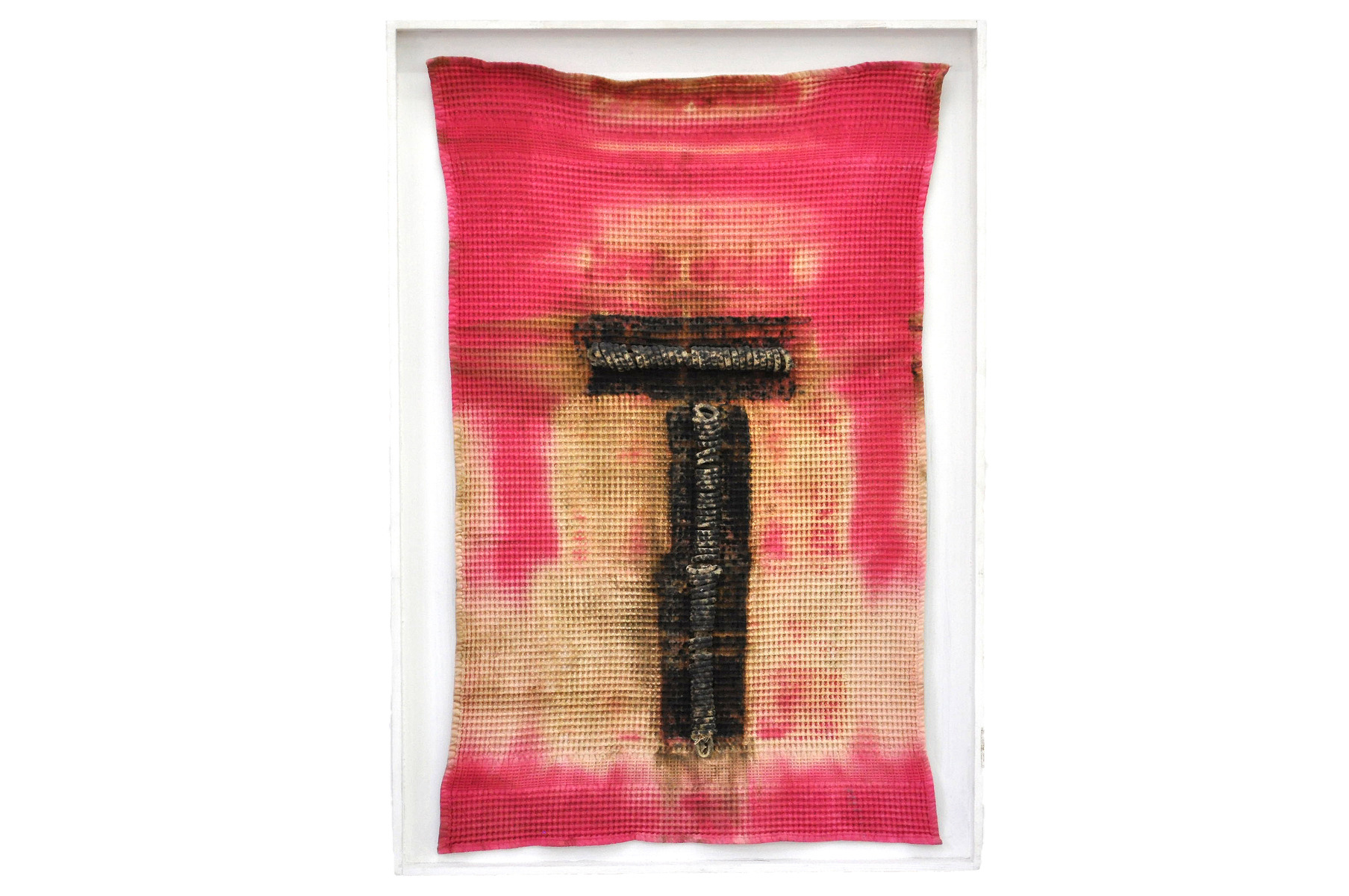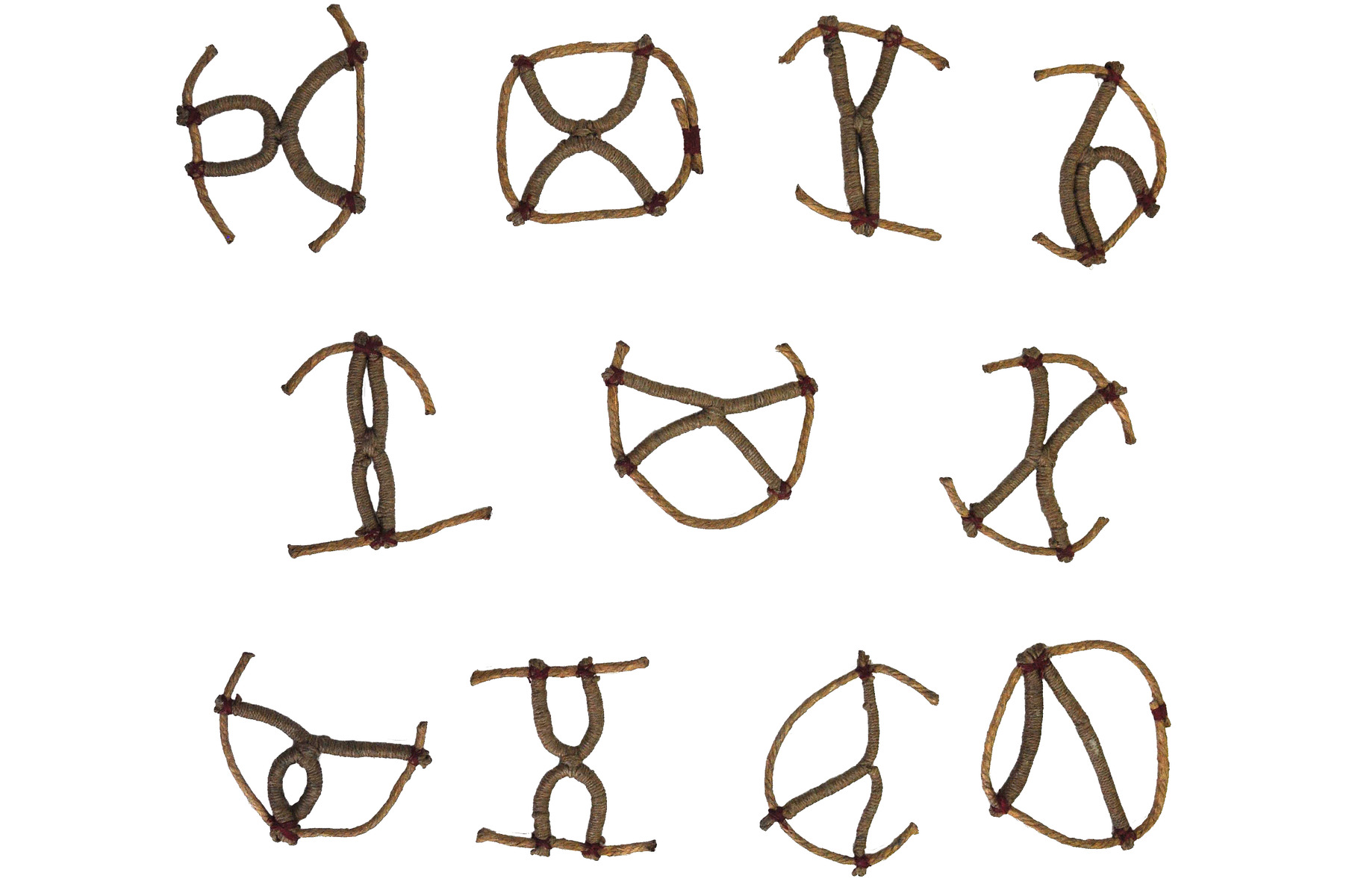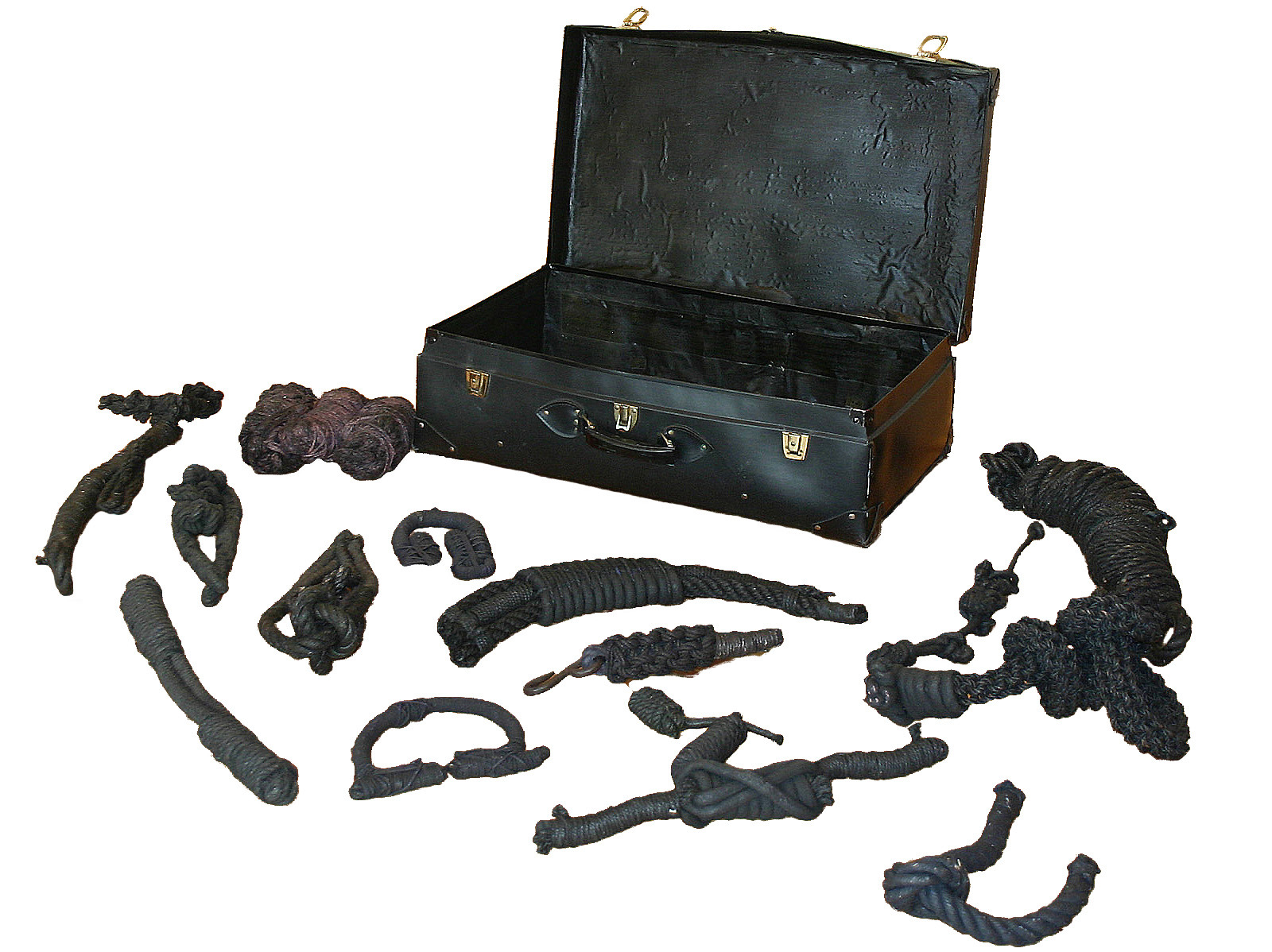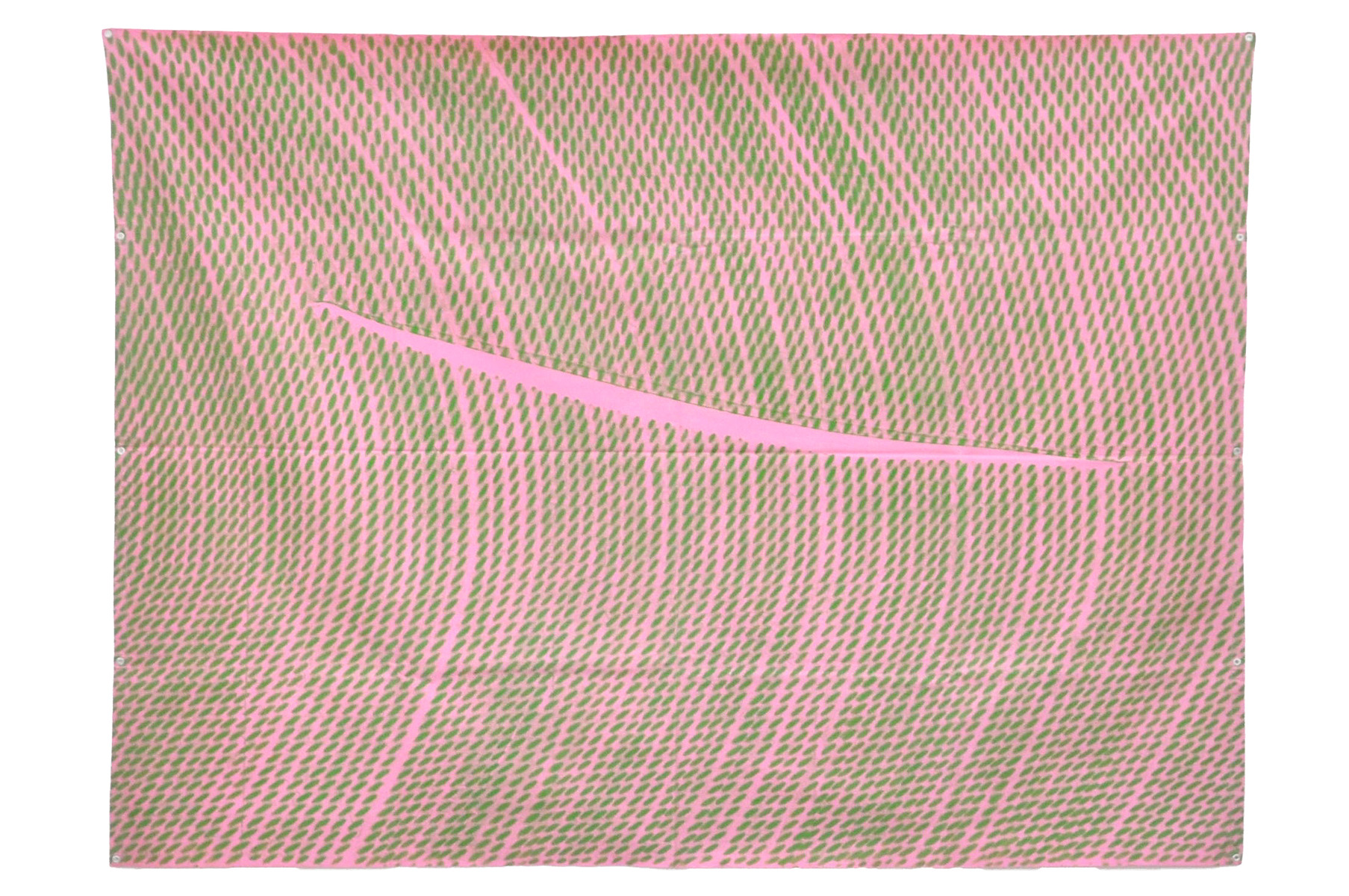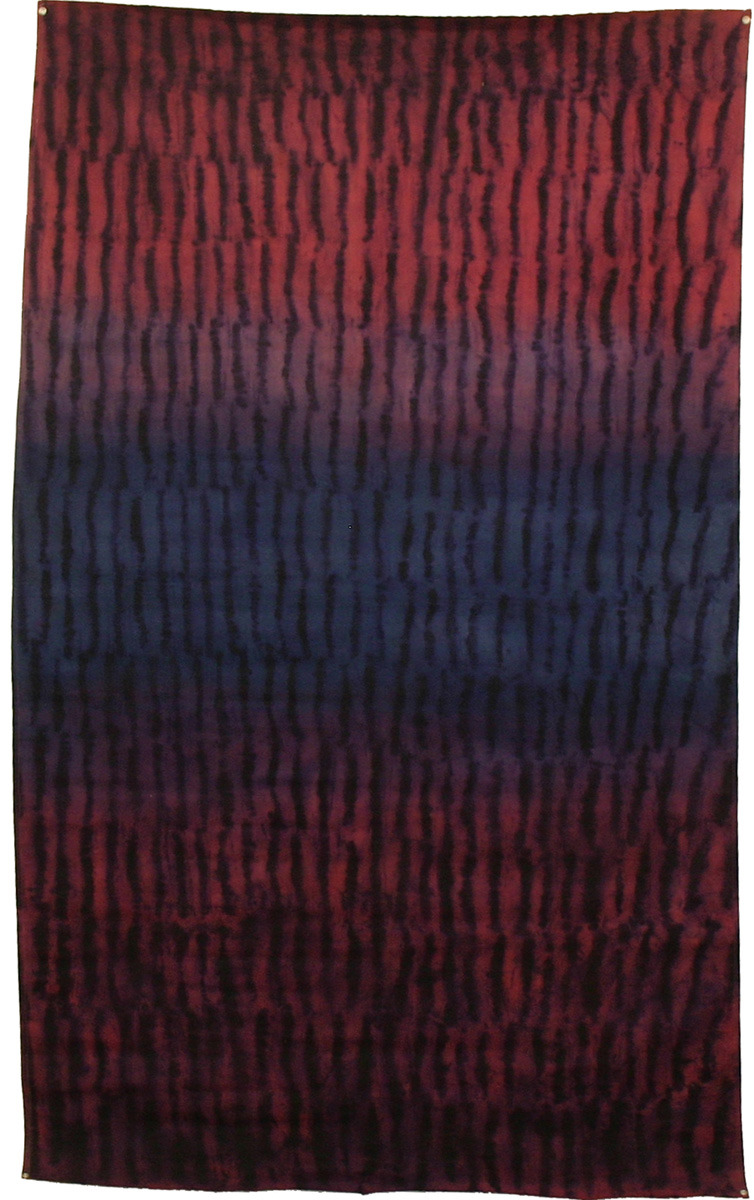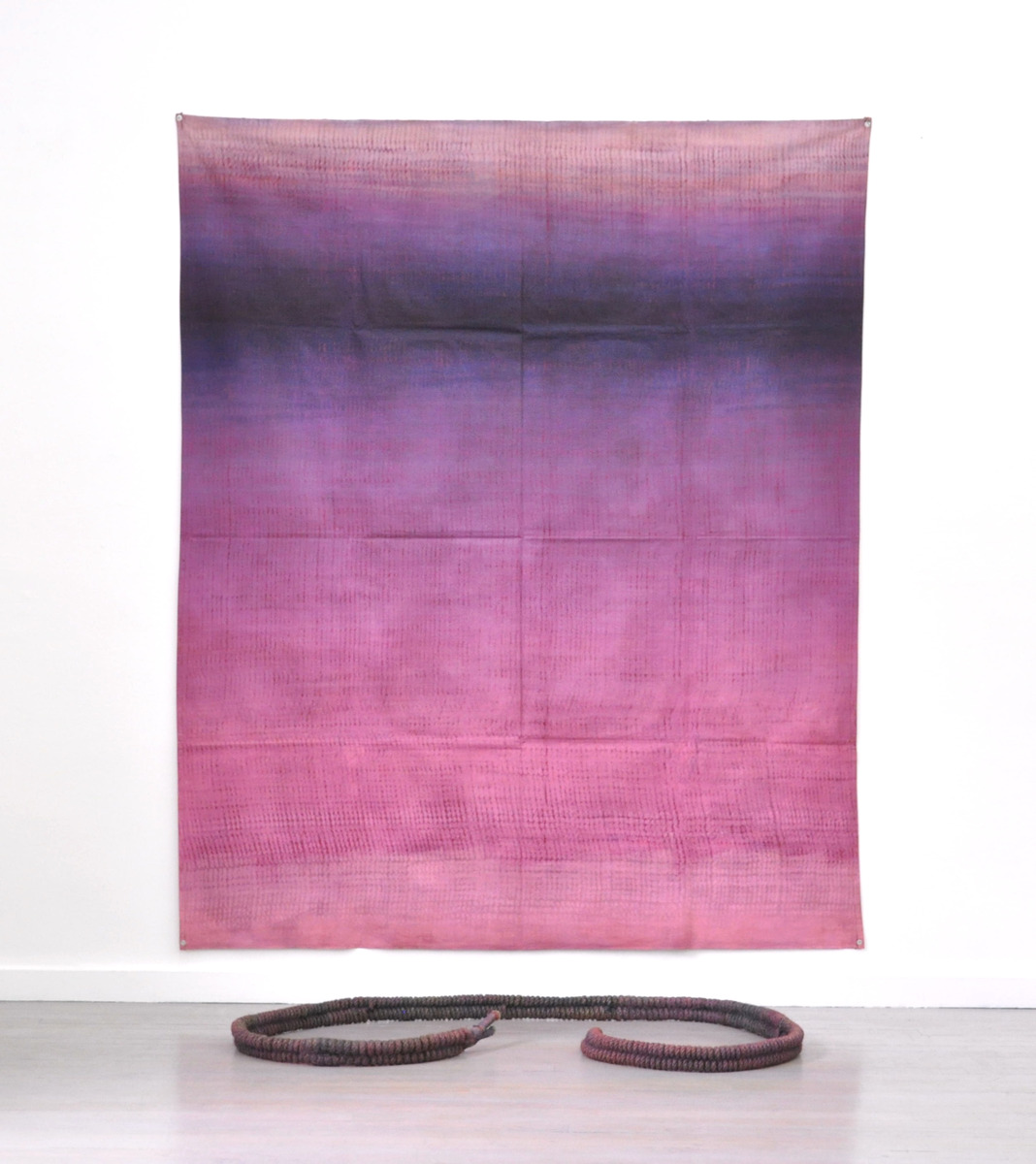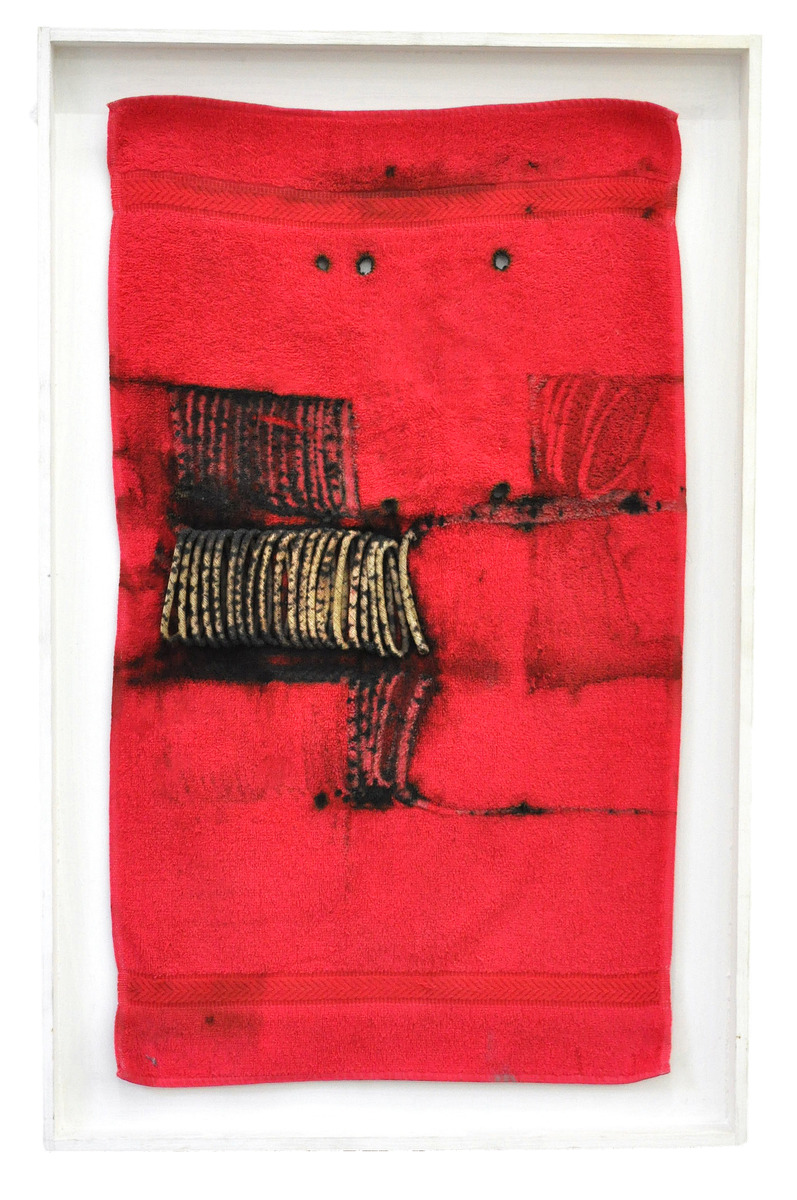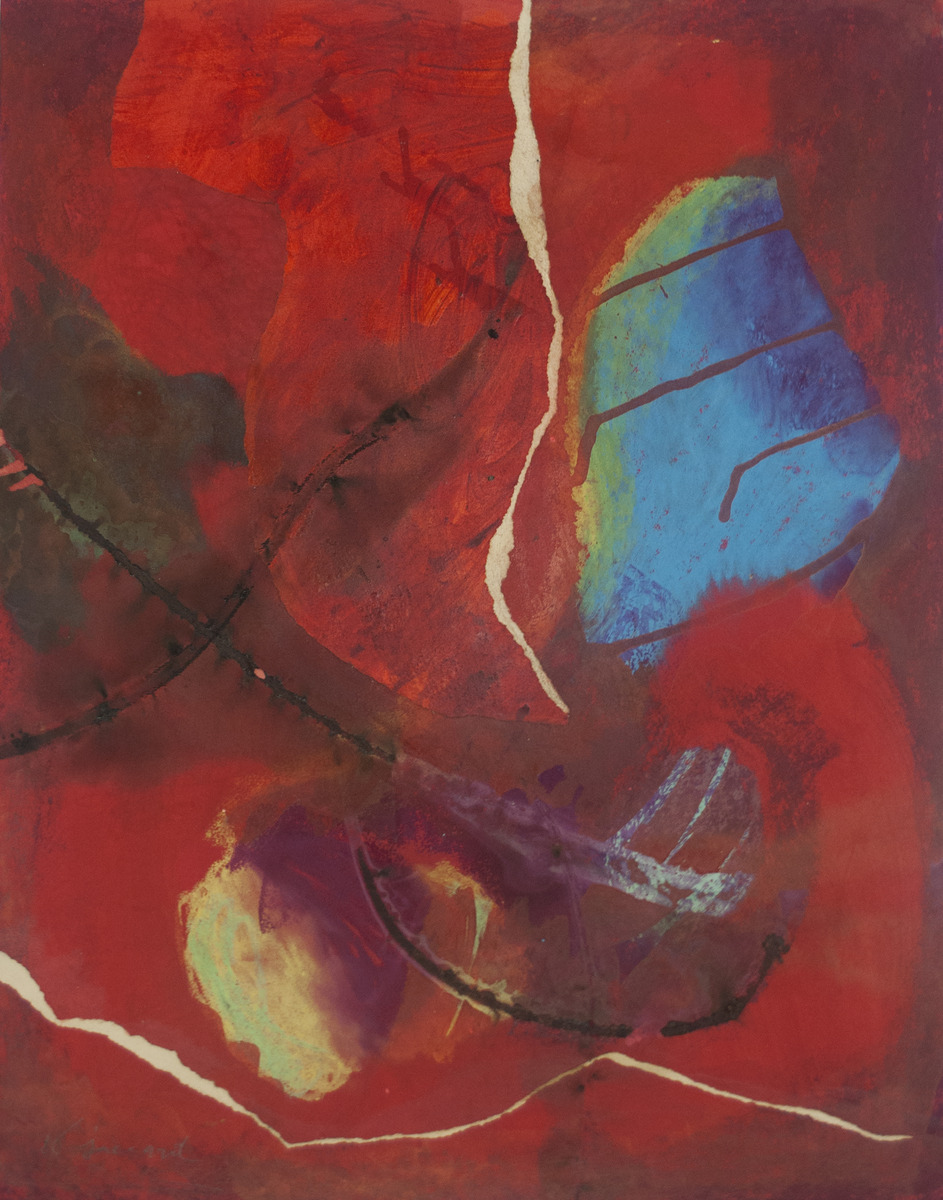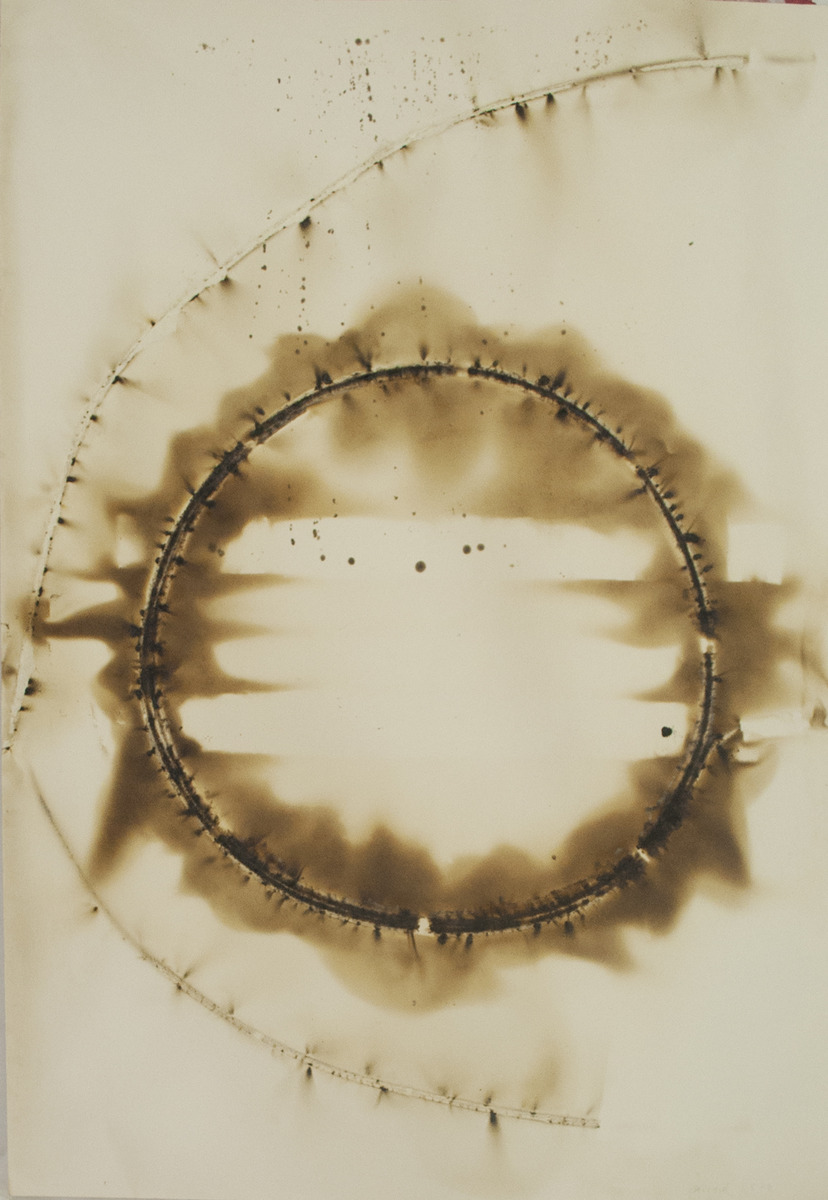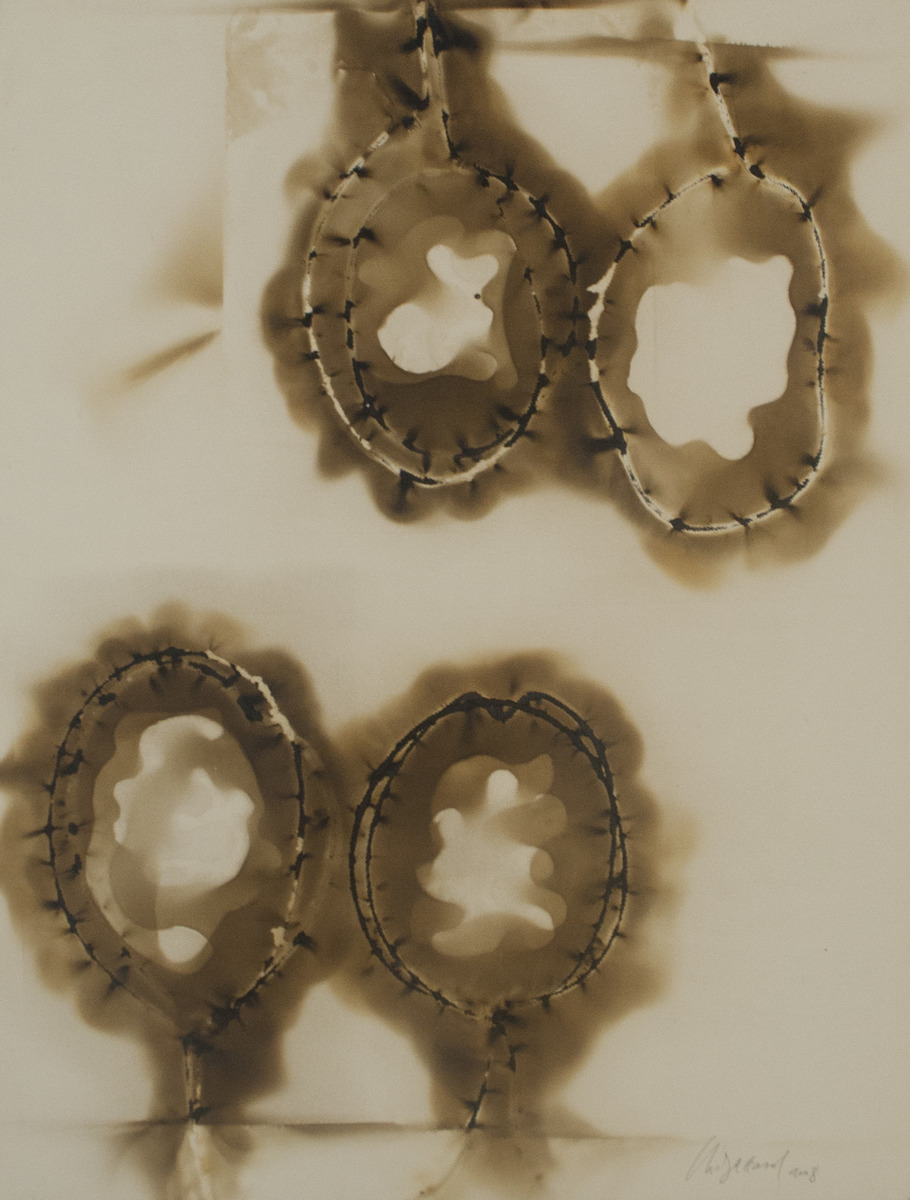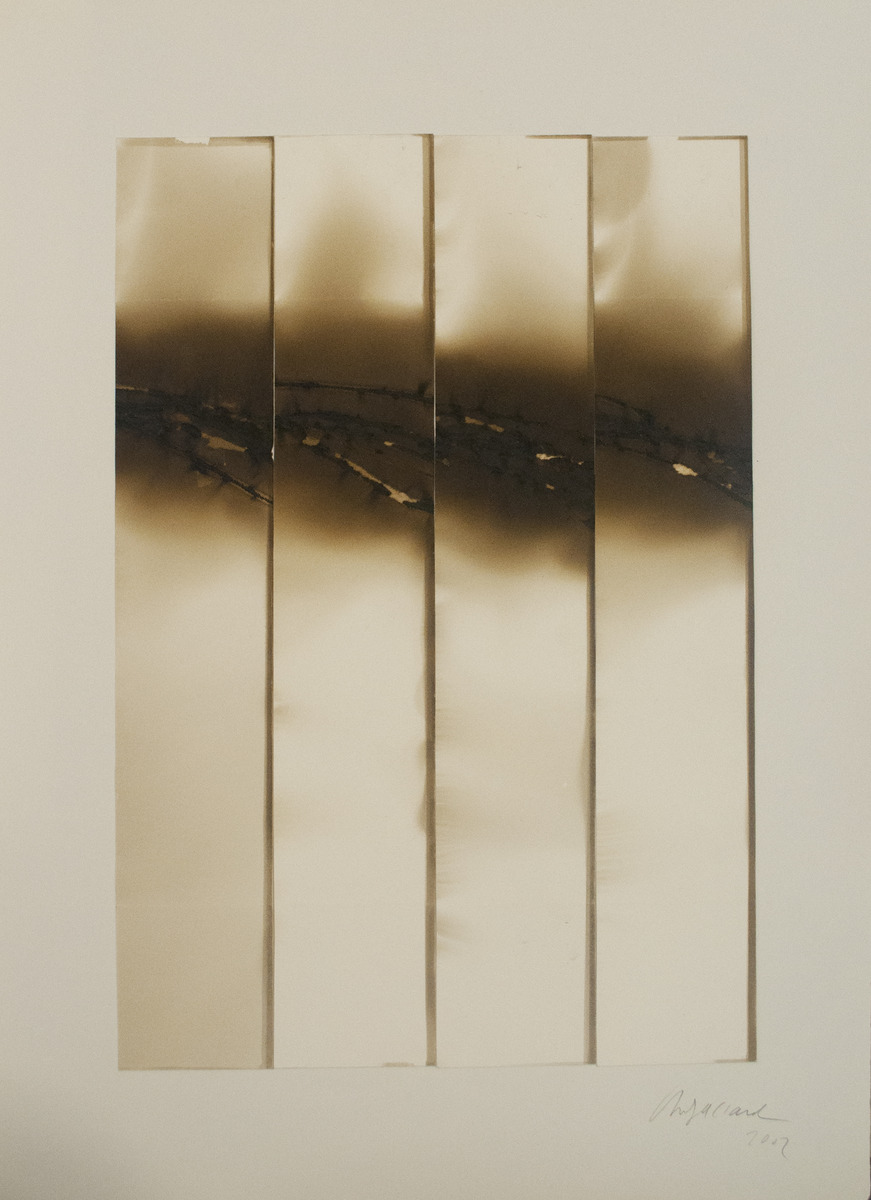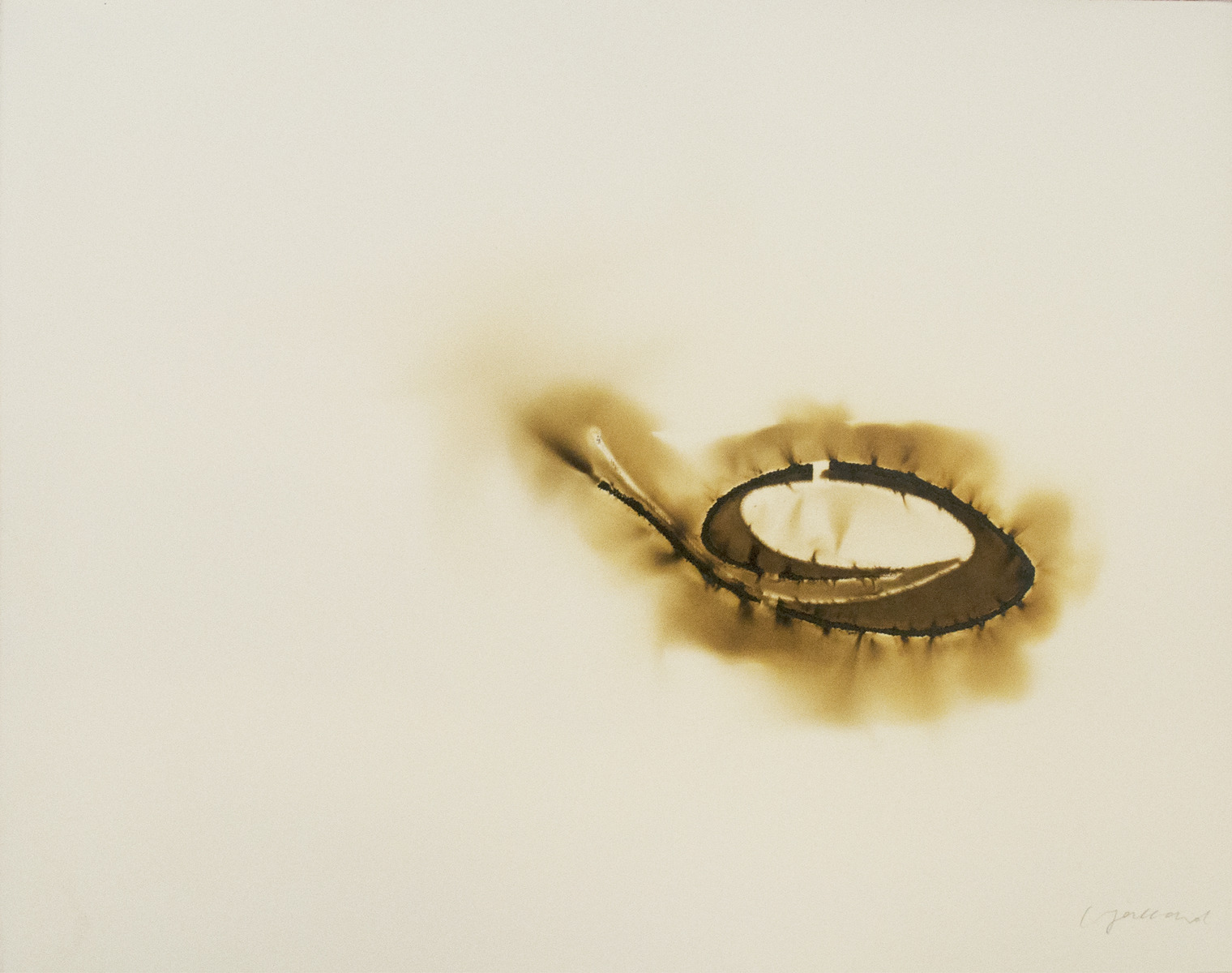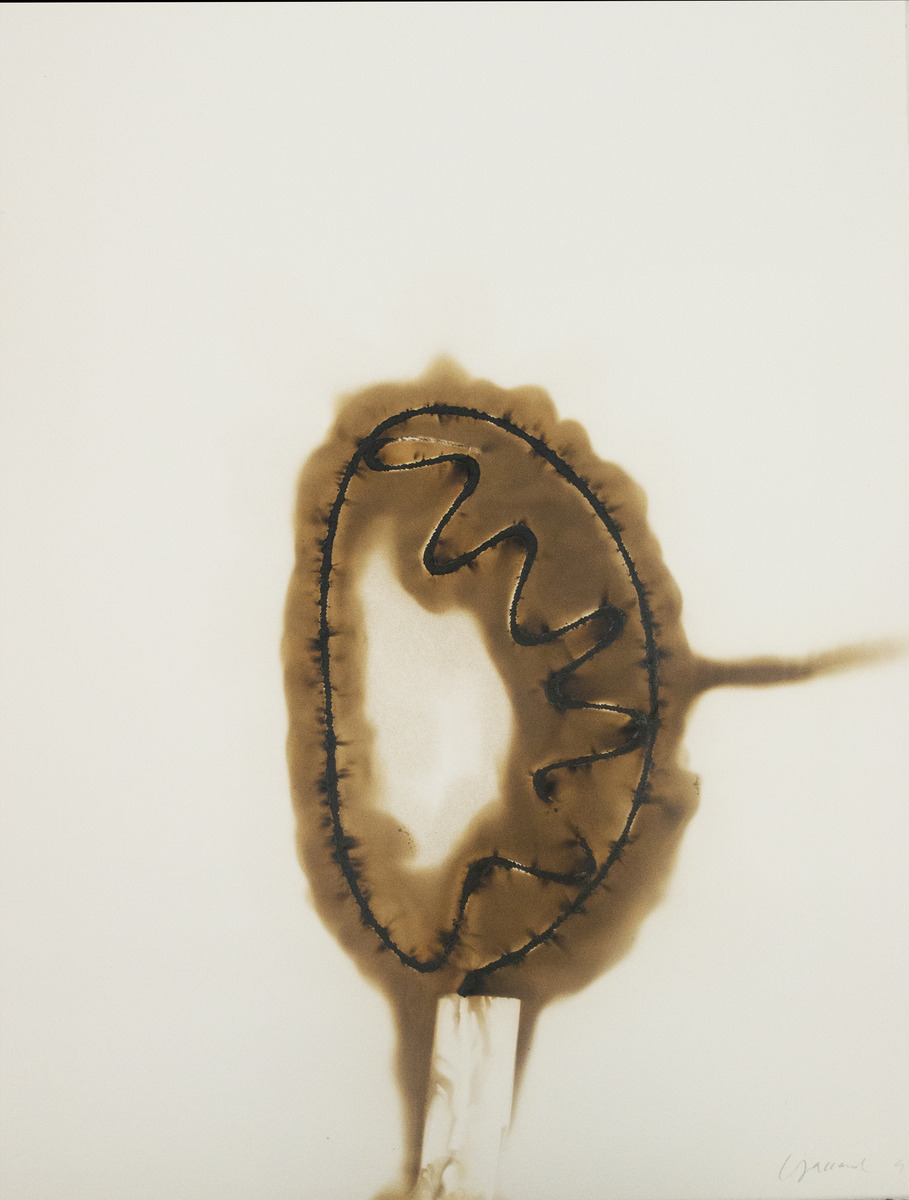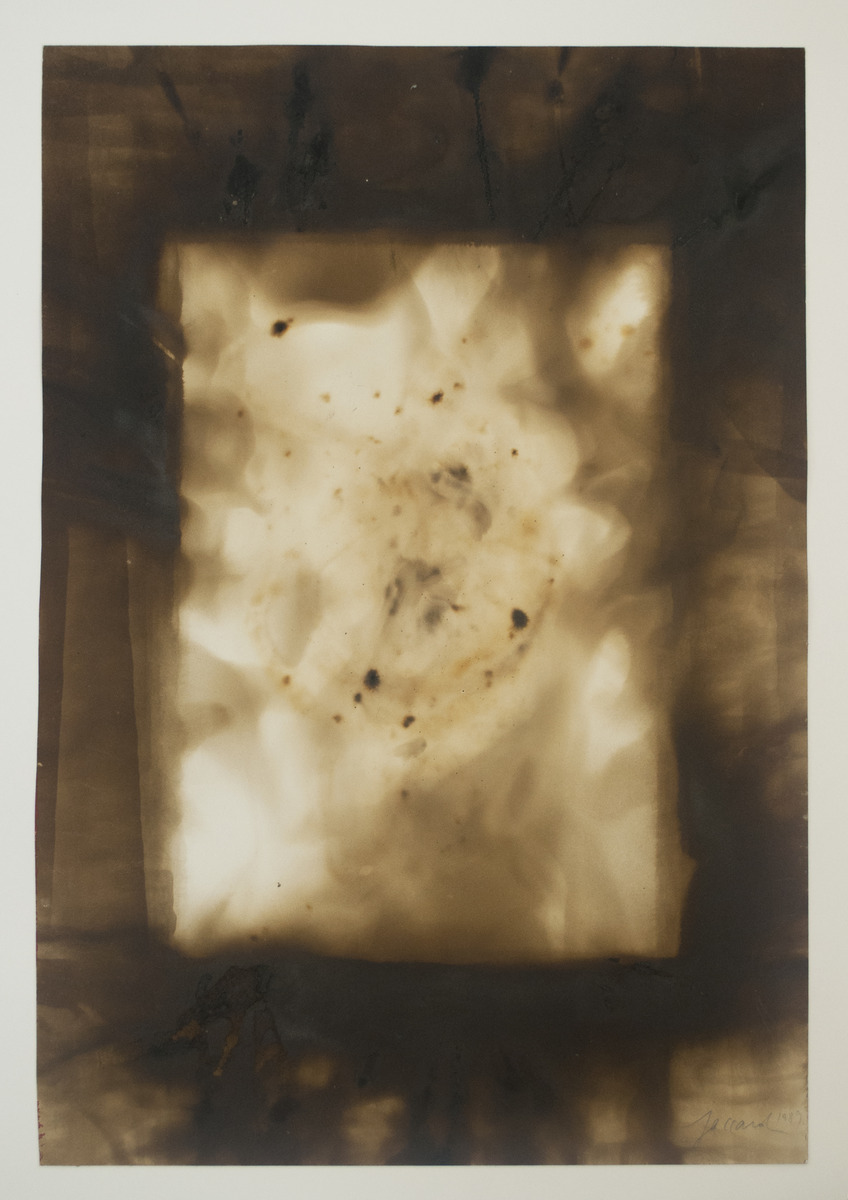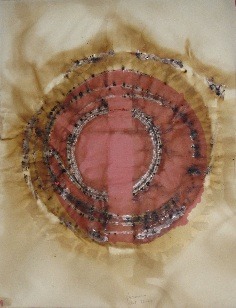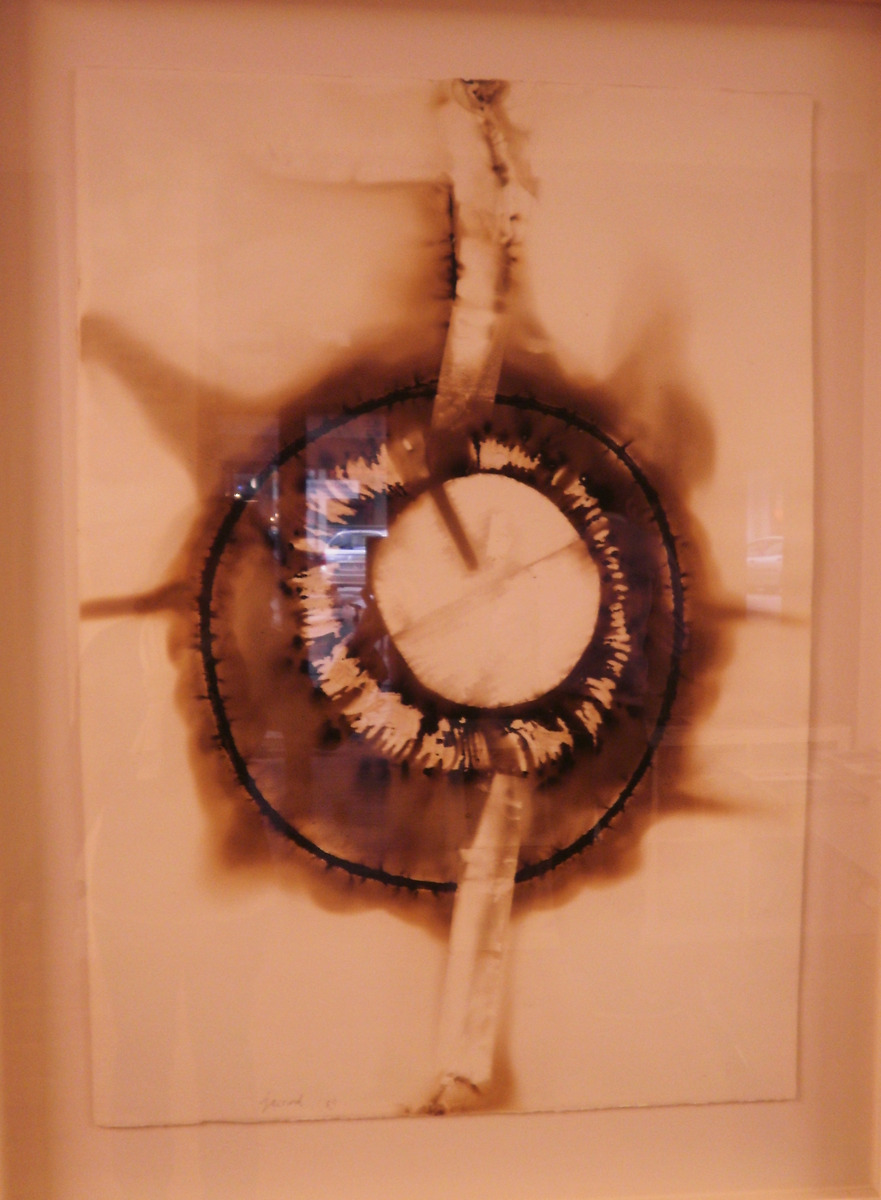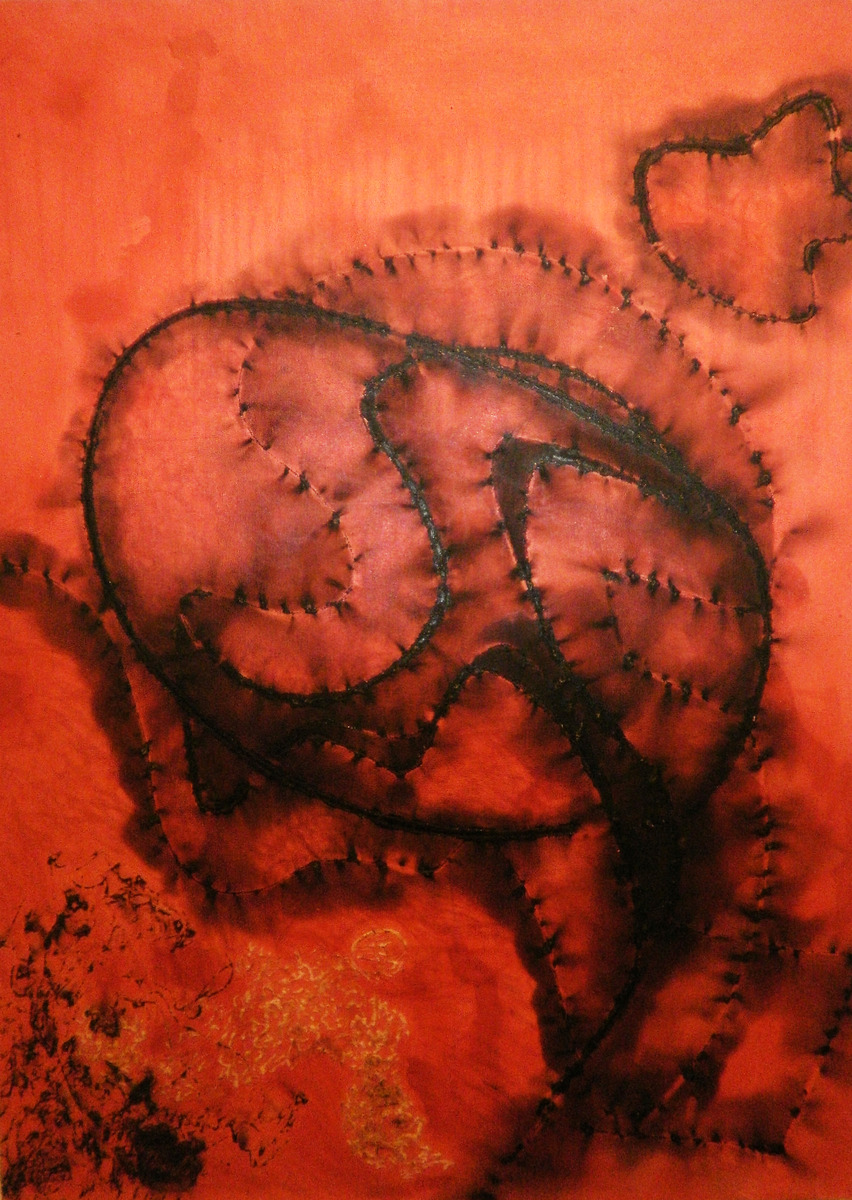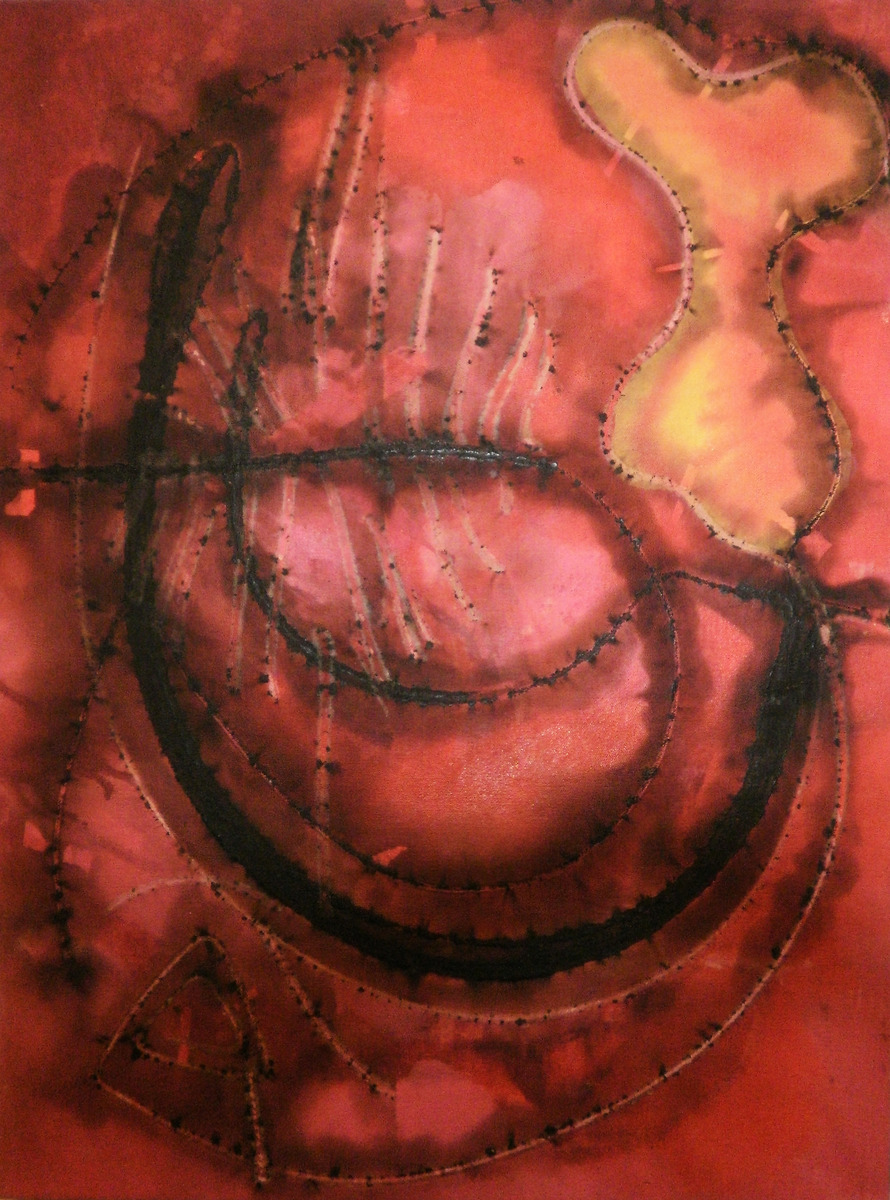Christian Jaccard

Christian Jaccard
Born in 1939, in Fontenay-sous-Bois, France
Lives and works in Paris, France
Education
1956-60 Bourges Fine Art School, France
Presentation
In 1970, Christian Jaccard starts marking un-stretched canvases with indefinite impressions and stitches the canvas with twine evoking scarred skin. A confection of pseudo-tools made ropes joined with simple or complex knots charged with ink and used for stamping are positioned from top to bottom of the support so as to codify his systemic process. These tools that Jaccard never uses are less sculptures than singular objects. The tying activity demonstrates no affect. The artist is concerned with reconstructing painting beyond a simple formalist game involving its power to signify. Particularly when he made tools out of safety fuses that he wrapped and then lit with sheathes of colored canvases. It is the combination of the materiality of the surfaces and the tools used with respect to their function that gives rise to works in which the memory of materiality is inscribed. Yet the quest for an impossible sublimation are also present.
Lives and works in Paris, France
Education
1956-60 Bourges Fine Art School, France
Presentation
In 1970, Christian Jaccard starts marking un-stretched canvases with indefinite impressions and stitches the canvas with twine evoking scarred skin. A confection of pseudo-tools made ropes joined with simple or complex knots charged with ink and used for stamping are positioned from top to bottom of the support so as to codify his systemic process. These tools that Jaccard never uses are less sculptures than singular objects. The tying activity demonstrates no affect. The artist is concerned with reconstructing painting beyond a simple formalist game involving its power to signify. Particularly when he made tools out of safety fuses that he wrapped and then lit with sheathes of colored canvases. It is the combination of the materiality of the surfaces and the tools used with respect to their function that gives rise to works in which the memory of materiality is inscribed. Yet the quest for an impossible sublimation are also present.
The acknowledgment of a failure
"I was not interested in the absurdity of the act of painting, but in the useless or powerless nature of it to produce something efficient, effective, radical, something which would provide brightness or magic from the material to the look."
To sum up his approach, Christian Jaccard explains he had noted a lack, the powerlessness of a mode of expression which he inherited: painting. And painting is essential, in every sense of the word, to express what is tangible, that is to say the amazement, the emotion, the desire and the emptiness of being-in-the-world. However, admitting the failure of painting has not driven him to consider that it would be absurd for him to keep on painting, but painting is so codified and controlled that it has led him to reach a deadlock.
Already exhausted by getting bogged down in the metaphors for reality, painting was destabilised by the diverse changes tried out to make it emerge from these metaphors. Painting was also competed by a new way of transcribing the real-photography and then, cinema-which could make stories legitimate and keep memory transient. Painting had lost its main cornerstone. Not to mention that the laicisation of its project had condemned it to express transcendence.
By dint of shifts and questionings of this historical, social and ideological construction which is painting, its space divided up, through successive detachments (trivialisation of referents, decomposition of a coloured feeling, empowerment of colour, shape, dissociation of colour and shape, dilution of a constructed shape, diversion and flattening of the illusionist space by driving shapes and stories towards a two-dimensional space, dismemberment of stories for the benefit of the stimulation of pure sensation, growing importance of ideas). Painting is moving away all the time from its traditional balance point. It is on the verge of collapse.
But above all, painting will always be considered as a piece of furniture, firmly rooted under the plane surface of the object it makes up: the picture, the canvas. Painting is obstructed by a status which hangs heavy on it while putting it on a pedestal of values.
The conceptual approach was the last stage of painting. However-and in the radical sense of the expression "conceptual approach"-by eluding or deferring the transition from the idea to the plastic execution of this idea, by displaying only the graphic translation through a mise en scène of writing, or even by limiting the project to this writing only (excluding the image of the word), the conceptual approach has shown its limits. In fact and at best, the conceptual approach merely shifted the visibility and materiality of the project upstream. The conceptual approach vanished into contortions of displays.
It was nevertheless the case that this set of issues, or this "utopia", which heralded the death of art and the concomitant disappearance of painters-as the professionals of an out of date mode-by carrying the crisis of painting to extremes, led to a questioning about the nature of art itself, its justifications, and cast doubt on its obviousness. Some would be tempted to wipe the slate clean. Others, who were aware that the end of History, or the post-History, or post-historicity, was still History said in different words, would focus on learning their lesson from these evolutions which turned painting away from the framework of its practice (the canvas) to go back, guided by Matisse's style, to the essential of painting, that is to say, handling colors.
Text by Jean-Paul Blanchet.
"I was not interested in the absurdity of the act of painting, but in the useless or powerless nature of it to produce something efficient, effective, radical, something which would provide brightness or magic from the material to the look."
To sum up his approach, Christian Jaccard explains he had noted a lack, the powerlessness of a mode of expression which he inherited: painting. And painting is essential, in every sense of the word, to express what is tangible, that is to say the amazement, the emotion, the desire and the emptiness of being-in-the-world. However, admitting the failure of painting has not driven him to consider that it would be absurd for him to keep on painting, but painting is so codified and controlled that it has led him to reach a deadlock.
Already exhausted by getting bogged down in the metaphors for reality, painting was destabilised by the diverse changes tried out to make it emerge from these metaphors. Painting was also competed by a new way of transcribing the real-photography and then, cinema-which could make stories legitimate and keep memory transient. Painting had lost its main cornerstone. Not to mention that the laicisation of its project had condemned it to express transcendence.
By dint of shifts and questionings of this historical, social and ideological construction which is painting, its space divided up, through successive detachments (trivialisation of referents, decomposition of a coloured feeling, empowerment of colour, shape, dissociation of colour and shape, dilution of a constructed shape, diversion and flattening of the illusionist space by driving shapes and stories towards a two-dimensional space, dismemberment of stories for the benefit of the stimulation of pure sensation, growing importance of ideas). Painting is moving away all the time from its traditional balance point. It is on the verge of collapse.
But above all, painting will always be considered as a piece of furniture, firmly rooted under the plane surface of the object it makes up: the picture, the canvas. Painting is obstructed by a status which hangs heavy on it while putting it on a pedestal of values.
The conceptual approach was the last stage of painting. However-and in the radical sense of the expression "conceptual approach"-by eluding or deferring the transition from the idea to the plastic execution of this idea, by displaying only the graphic translation through a mise en scène of writing, or even by limiting the project to this writing only (excluding the image of the word), the conceptual approach has shown its limits. In fact and at best, the conceptual approach merely shifted the visibility and materiality of the project upstream. The conceptual approach vanished into contortions of displays.
It was nevertheless the case that this set of issues, or this "utopia", which heralded the death of art and the concomitant disappearance of painters-as the professionals of an out of date mode-by carrying the crisis of painting to extremes, led to a questioning about the nature of art itself, its justifications, and cast doubt on its obviousness. Some would be tempted to wipe the slate clean. Others, who were aware that the end of History, or the post-History, or post-historicity, was still History said in different words, would focus on learning their lesson from these evolutions which turned painting away from the framework of its practice (the canvas) to go back, guided by Matisse's style, to the essential of painting, that is to say, handling colors.
Text by Jean-Paul Blanchet.
Solo shows at Ceysson Gallery
Christian Jaccard, Saint-Etienne
May 20 - August 29, 2010
Group shows at Ceysson Gallery
SUPPORTS / SURFACES, Saint-Etienne
May 30 - August 30, 2008
Shows (selection)
2017
Supports/Suffaces: L’histoire Continue, Galerie Jean-Jacques Dutko, Paris, France
2015
Christian Jaccard - énergies dissipées Fontenoy, Centre régional d'art contemporain de Fontenoy, Fontenoy, France
Christian Jaccard - énergies dissipées, Valérie Bach Gallery, Brussels, Belgium
2014
Christian Jaccard : Tableaux Ephémères Centre Pompidou, Paris, France
SIGNA MENTIS. Une installation de Christian Jaccard Musée de Picardie, Amiens, France
SURFACE(S) / PRISE(S) Galerie Christophe Gaillard, Paris, France
2013
VIe Biennale de Melle, Melle, France
Christian Jaccard. Feux sacrés Musée-château d'Annecy, Annecy, France
2012
Christian Jaccard. Agrégations ABBAYE SAINT ANDRE, Centre d'art contemporain, Meymac, Meymac, France
Energies dissipées Musée de Soissons, Soissons, France
Énergies dissipées Domaine de Kerguéhennec Centre d'art, Bignan, France
Villa Tamaris Centre d'art, La Seyne-sur-mer, France
Énergies dissipées, EACAM, Colmar, France
2010
Migrations Saisonnières Chapelle Sainte Marie, Annonay, France
Toni Grand et Christian Jaccard Château de La Roche-Guyon, La Roche-Guyon, France
2008
Lithocombustions et papiers choisis invité d'honneur de la 17ème édition de L'art dans les Chapelles, Hennebont, Galerie Pierre Tal-Coat, Hennebont, France
7ème édition de L'art dans les Chapelles Pays de Pontivy - Morbihan - Bretagne ; Chapelle de La Trinité, Castennec, Bieuzy-les-Eaux, en partenariat avec la Galerie Pierre Tal-Coat, Hennebont, France
Combustions Galerie de l'Ancien Collège, Châtellerault, France
CorrespondancesMusée d'Orsay, Paris, France
2003
Le Maître des ombres FRAC Auvergne, Espace Boris Vian, Montluçon
20 ans, FRAC Basse-Normandie, Caen, France
La réponse est dans le ciel Station de métro Saint-Germain-des-Prés, Paris, France
2002
Eclipse, œuvres sur papier Aldébaran, Baillargues, France
Autour de supports/surfaces, dessins et objets, collection du Musée
d'Art moderne, Saint-Etienne Musée de Valence, Valence, France
Questions de peinture Centre international d'Art contemporain, Carros, France
The 12th Space International Print Biennal Sungkok Art Museum, Seoul, South-Korea
1992-2002. 10 ans d'art Galerie municipale Julio Gonzalez, Arcueil, France
Les années 70, l'art en cause CAPC, Bordeaux, France
2001
Grands papiers du FRAC Picardie Abbaye Saint-Jean des Vignes, Soissons, France
2000
La Couleur à l'épreuve du feu, céramiques d'artistes de 1885 à 2000 Musée de la Faïence, Marseille, France
Mémoires provisoires FRAC Auvergne, Vichy, France
Exposition à la galerie Bernard Ceysson
2008
Exposition collective, Supports / Surfaces, Galerie Bernard Ceysson, Saint-Etienne, http://www.bernardceysson.com/fiche-exposition.php?lieu=lux&expo=expo_lux_1>voir la fiche de l'exposition.
Christian Jaccard, Saint-Etienne
May 20 - August 29, 2010
Group shows at Ceysson Gallery
SUPPORTS / SURFACES, Saint-Etienne
May 30 - August 30, 2008
Shows (selection)
2017
Supports/Suffaces: L’histoire Continue, Galerie Jean-Jacques Dutko, Paris, France
2015
Christian Jaccard - énergies dissipées Fontenoy, Centre régional d'art contemporain de Fontenoy, Fontenoy, France
Christian Jaccard - énergies dissipées, Valérie Bach Gallery, Brussels, Belgium
2014
Christian Jaccard : Tableaux Ephémères Centre Pompidou, Paris, France
SIGNA MENTIS. Une installation de Christian Jaccard Musée de Picardie, Amiens, France
SURFACE(S) / PRISE(S) Galerie Christophe Gaillard, Paris, France
2013
VIe Biennale de Melle, Melle, France
Christian Jaccard. Feux sacrés Musée-château d'Annecy, Annecy, France
2012
Christian Jaccard. Agrégations ABBAYE SAINT ANDRE, Centre d'art contemporain, Meymac, Meymac, France
Energies dissipées Musée de Soissons, Soissons, France
Énergies dissipées Domaine de Kerguéhennec Centre d'art, Bignan, France
Villa Tamaris Centre d'art, La Seyne-sur-mer, France
Énergies dissipées, EACAM, Colmar, France
2010
Migrations Saisonnières Chapelle Sainte Marie, Annonay, France
Toni Grand et Christian Jaccard Château de La Roche-Guyon, La Roche-Guyon, France
2008
Lithocombustions et papiers choisis invité d'honneur de la 17ème édition de L'art dans les Chapelles, Hennebont, Galerie Pierre Tal-Coat, Hennebont, France
7ème édition de L'art dans les Chapelles Pays de Pontivy - Morbihan - Bretagne ; Chapelle de La Trinité, Castennec, Bieuzy-les-Eaux, en partenariat avec la Galerie Pierre Tal-Coat, Hennebont, France
Combustions Galerie de l'Ancien Collège, Châtellerault, France
CorrespondancesMusée d'Orsay, Paris, France
2003
Le Maître des ombres FRAC Auvergne, Espace Boris Vian, Montluçon
20 ans, FRAC Basse-Normandie, Caen, France
La réponse est dans le ciel Station de métro Saint-Germain-des-Prés, Paris, France
2002
Eclipse, œuvres sur papier Aldébaran, Baillargues, France
Autour de supports/surfaces, dessins et objets, collection du Musée
d'Art moderne, Saint-Etienne Musée de Valence, Valence, France
Questions de peinture Centre international d'Art contemporain, Carros, France
The 12th Space International Print Biennal Sungkok Art Museum, Seoul, South-Korea
1992-2002. 10 ans d'art Galerie municipale Julio Gonzalez, Arcueil, France
Les années 70, l'art en cause CAPC, Bordeaux, France
2001
Grands papiers du FRAC Picardie Abbaye Saint-Jean des Vignes, Soissons, France
2000
La Couleur à l'épreuve du feu, céramiques d'artistes de 1885 à 2000 Musée de la Faïence, Marseille, France
Mémoires provisoires FRAC Auvergne, Vichy, France
Exposition à la galerie Bernard Ceysson
2008
Exposition collective, Supports / Surfaces, Galerie Bernard Ceysson, Saint-Etienne, http://www.bernardceysson.com/fiche-exposition.php?lieu=lux&expo=expo_lux_1>voir la fiche de l'exposition.
2014
Supports/Surfaces (english), Ceysson Editions d'Art, 2014
2013
Christian Jaccard et Lucie Cabanes, "Christian Jaccard. Feux sacrés", Musée-château d'Annecy, 2013.
2012
Christian Jaccard, "Énergies nouées, énergies dissipées : l'obsession du temps et de sa perte" by Blanchet Jean-Paul, Ceysson éditions d'art, 2012
Agrégations, foreword by Blanchet Jean-Paul, Ceysson Editions d'Art, Centre d'art contemporain, Meymac, 2012
Jean-Paul Gavard-Perret, « Tout feu, tout flamme. (Divers états de l'action burning) », in artpointfrance, February 2012.
François Xavier, Nuit blanche 2012: Christian Jaccard mettra-t-il le feu à l'Hôtel de Ville?, in Huffington, October 2012.
2011
Château Dominique, Énergie Dissipées, Editions Bernard Chauveau, Paris, 2011
"Conversations. Christian Jaccard", Editions Beaux-Arts de Paris, 2011
Michael Bishop, "Contemporary French Art 2: Gerard Garouste, Colette Deble, Georges Rousse, Genevieve Asse, Martial Raysse, Christian Jaccard, Joel Kermarrec, Dan", Ed. Rodopi, 2011
2010
Jaccard Christian, Conversations, foreword by Semin Didier, Editions de l'ENSBA, Paris, 2010
Le Moment Supports/Surfaces, Ceysson Editions d'Art, 2010
2008
Correspondance, Christian Jaccard/Georges Hendrick Breitner, foreword by Jamet-Chavigny Stéphanie and Madeline Laurence, Editions Argol, Musée d'Orsay, Paris, 2008
2007
Bessaa Mona, Le Feu et la flamme dans l'art contemporain, Editions L'Harmattan, Paris, 2007
2005
Jaccard Christian, Nomadic writings, 1989-2000, the art of fire and knot works, Editions VVV Editions, Halifax, Nouvelle-Écosse, 2005
2003
Lascault Gilbert, Christian Jaccard, l'évènement et sa trace, Editions Adam Biro, Paris, 2003
2002
Bonn Sally, Chartier Didier-A, Cyroulnik Philippe, Domino Christophe, Joppolo Giovani, Lebahar Jean-Charles, Muntaner Bernard, Reut Tita, Une Oeuvre de Jaccard, Editions Muntaner, collection Iconotexte, Marseille, 2002
Christian Jaccard, en noir et blanc, 1993-2000, interview Charrière Edmond, Editions Musée des Beaux-Arts, La Chaux-de-Fonds, 2002
1998
Joppolo Giovani, L'Outil, la trace. La matière dans l'art contemporain, Profil d'une collection, Editions FRAC Basse-Normandie, Caen, 1998
Lebahar Jean-Charles, Christian Jaccard, processus d'une création, Editions Au Même Titre, Paris, 1998
1997
Dessins et objets, 1975-1995, foreword by Semin Didier, Musée d'Art moderne Saint-Etienne, Le 19, Centre d'art contemporain de Montbéliard, 1996, National Museum of Art, Osaka, 1997
1992
Jappolo Giovani, Mise à feu, Editions Galerie Thorigny, Éric Koehler, Paris, 1992
1991
Mavrommatis Manolis, Christian Jaccard, Editions Mission laïque, Institut français, Thessalonique, 1994
Brûlis 1989-1990, foreword by Restany Pierre, Editions Galerie Louis Carré & Cie, Paris, 1991
1990
Christian Jaccard, Les Blancs et les rouges, 1983-1989, foreword by Joppolo Giovani and Viatte Germain, Editions Images en Manoeuvres, Musée Cantini, Marseille, 1990
1987
Christian Jaccard, le feu glorieux, foreword by Bonito Oliva Achille and Lemaire Gérard-Georges, Editions Carte Segrete, Rome, 1987
Noël Bernard, Le Roman des noeuds, Editions La Différence, Paris, 1987
1985
Papiers calcinés, 1974-1984, foreword by Ceysson Bernard, Editions CAC Pablo Neruda, Corbeil-Essonnes, 1985
1984
Jaccard Christian, De l'usage du feu, Lithographies 1968-1984, Editions Franck Bordas, Paris, 1984
1983
Anonymes calcinés, foreword by Fournet Claude, Hauc Jean-Claude, Laporte Dominique-Gilbert and Lemaire Gérard-Georges, Editions Musées de Nice, Nice, 1983
1982
Laporte Dominique-Gilbert, Jaccard ou la réparation, Editions Galerie Jan Six, Paris, 1982
1979
Suites calcinées, 1976-1978, foreword by Pagé Suzanne and Lemaire Gérard-Georges, Editions Musée d'Art moderne de la Ville de Paris, Paris, 1979
1976
Christian Jaccard : le seul triomphe du rite est de suspendre un moment la dégradation, foreword by Michaud Yves, Editions Musée d'Art et d'Industrie, Saint-Etienne, 1976
1975
Christian Jaccard, 12 Couples toiles/outils 73-74 et empreintes, foreword by Fournet Claude and Pacquement Alfred, Cahiers de l'Abbaye Sainte-Croix, n°9, Editions Musée des Sables-d'Olonne, C.N.A.C. Georges Pompidou, Paris, 1975
1972
Jaccard Christian, Figurologie, Editions Musée de l'Athénée, Genève, 1972
Supports/Surfaces (english), Ceysson Editions d'Art, 2014
2013
Christian Jaccard et Lucie Cabanes, "Christian Jaccard. Feux sacrés", Musée-château d'Annecy, 2013.
2012
Christian Jaccard, "Énergies nouées, énergies dissipées : l'obsession du temps et de sa perte" by Blanchet Jean-Paul, Ceysson éditions d'art, 2012
Agrégations, foreword by Blanchet Jean-Paul, Ceysson Editions d'Art, Centre d'art contemporain, Meymac, 2012
Jean-Paul Gavard-Perret, « Tout feu, tout flamme. (Divers états de l'action burning) », in artpointfrance, February 2012.
François Xavier, Nuit blanche 2012: Christian Jaccard mettra-t-il le feu à l'Hôtel de Ville?, in Huffington, October 2012.
2011
Château Dominique, Énergie Dissipées, Editions Bernard Chauveau, Paris, 2011
"Conversations. Christian Jaccard", Editions Beaux-Arts de Paris, 2011
Michael Bishop, "Contemporary French Art 2: Gerard Garouste, Colette Deble, Georges Rousse, Genevieve Asse, Martial Raysse, Christian Jaccard, Joel Kermarrec, Dan", Ed. Rodopi, 2011
2010
Jaccard Christian, Conversations, foreword by Semin Didier, Editions de l'ENSBA, Paris, 2010
Le Moment Supports/Surfaces, Ceysson Editions d'Art, 2010
2008
Correspondance, Christian Jaccard/Georges Hendrick Breitner, foreword by Jamet-Chavigny Stéphanie and Madeline Laurence, Editions Argol, Musée d'Orsay, Paris, 2008
2007
Bessaa Mona, Le Feu et la flamme dans l'art contemporain, Editions L'Harmattan, Paris, 2007
2005
Jaccard Christian, Nomadic writings, 1989-2000, the art of fire and knot works, Editions VVV Editions, Halifax, Nouvelle-Écosse, 2005
2003
Lascault Gilbert, Christian Jaccard, l'évènement et sa trace, Editions Adam Biro, Paris, 2003
2002
Bonn Sally, Chartier Didier-A, Cyroulnik Philippe, Domino Christophe, Joppolo Giovani, Lebahar Jean-Charles, Muntaner Bernard, Reut Tita, Une Oeuvre de Jaccard, Editions Muntaner, collection Iconotexte, Marseille, 2002
Christian Jaccard, en noir et blanc, 1993-2000, interview Charrière Edmond, Editions Musée des Beaux-Arts, La Chaux-de-Fonds, 2002
1998
Joppolo Giovani, L'Outil, la trace. La matière dans l'art contemporain, Profil d'une collection, Editions FRAC Basse-Normandie, Caen, 1998
Lebahar Jean-Charles, Christian Jaccard, processus d'une création, Editions Au Même Titre, Paris, 1998
1997
Dessins et objets, 1975-1995, foreword by Semin Didier, Musée d'Art moderne Saint-Etienne, Le 19, Centre d'art contemporain de Montbéliard, 1996, National Museum of Art, Osaka, 1997
1992
Jappolo Giovani, Mise à feu, Editions Galerie Thorigny, Éric Koehler, Paris, 1992
1991
Mavrommatis Manolis, Christian Jaccard, Editions Mission laïque, Institut français, Thessalonique, 1994
Brûlis 1989-1990, foreword by Restany Pierre, Editions Galerie Louis Carré & Cie, Paris, 1991
1990
Christian Jaccard, Les Blancs et les rouges, 1983-1989, foreword by Joppolo Giovani and Viatte Germain, Editions Images en Manoeuvres, Musée Cantini, Marseille, 1990
1987
Christian Jaccard, le feu glorieux, foreword by Bonito Oliva Achille and Lemaire Gérard-Georges, Editions Carte Segrete, Rome, 1987
Noël Bernard, Le Roman des noeuds, Editions La Différence, Paris, 1987
1985
Papiers calcinés, 1974-1984, foreword by Ceysson Bernard, Editions CAC Pablo Neruda, Corbeil-Essonnes, 1985
1984
Jaccard Christian, De l'usage du feu, Lithographies 1968-1984, Editions Franck Bordas, Paris, 1984
1983
Anonymes calcinés, foreword by Fournet Claude, Hauc Jean-Claude, Laporte Dominique-Gilbert and Lemaire Gérard-Georges, Editions Musées de Nice, Nice, 1983
1982
Laporte Dominique-Gilbert, Jaccard ou la réparation, Editions Galerie Jan Six, Paris, 1982
1979
Suites calcinées, 1976-1978, foreword by Pagé Suzanne and Lemaire Gérard-Georges, Editions Musée d'Art moderne de la Ville de Paris, Paris, 1979
1976
Christian Jaccard : le seul triomphe du rite est de suspendre un moment la dégradation, foreword by Michaud Yves, Editions Musée d'Art et d'Industrie, Saint-Etienne, 1976
1975
Christian Jaccard, 12 Couples toiles/outils 73-74 et empreintes, foreword by Fournet Claude and Pacquement Alfred, Cahiers de l'Abbaye Sainte-Croix, n°9, Editions Musée des Sables-d'Olonne, C.N.A.C. Georges Pompidou, Paris, 1975
1972
Jaccard Christian, Figurologie, Editions Musée de l'Athénée, Genève, 1972
